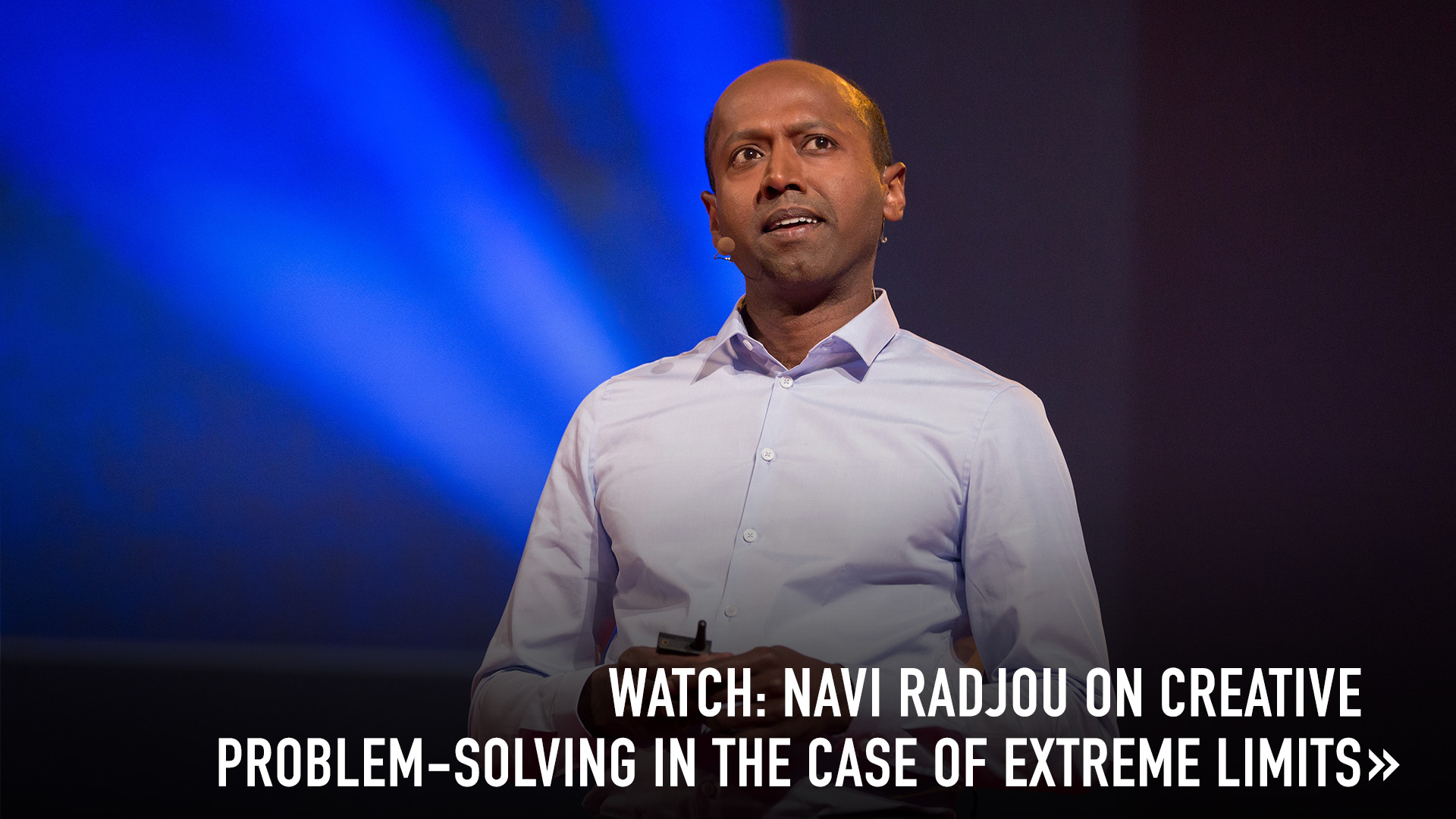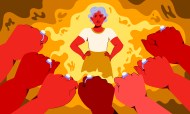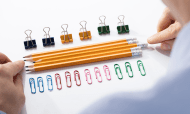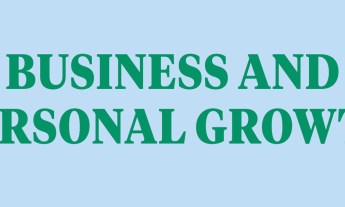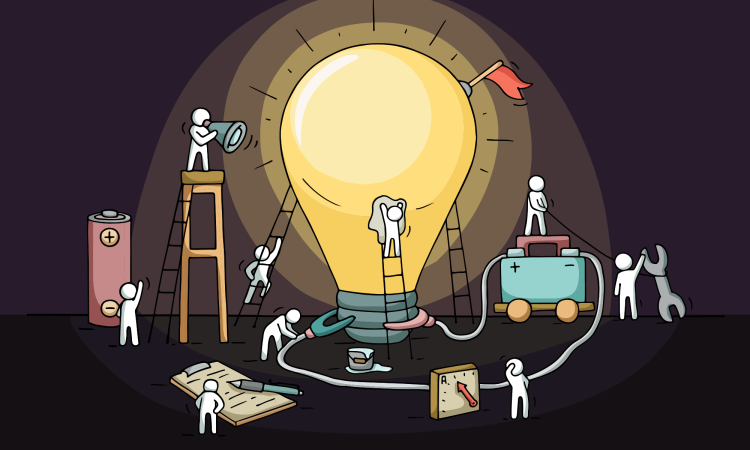
Human creativity is a natural, infinitely renewable resource — and it’s coming up with smart, cheap solutions to people’s biggest problems. Strategist Navi Radjou explains.
If an optimist sees the opportunity in every difficulty, then the developing world must be filled with optimists. There, people have learned to get more value from limited resources and find creative ways to reuse what they already have. For example, in India, potter Mansukh Prajapati has created a fridge made entirely of clay that uses no electricity and can keep fruits and vegetables fresh for many days — it is, quite literally, a cool invention. In Africa, if your cell phone battery runs low on power, you can often find resourceful entrepreneurs who’ll recharge it with their bicycle. And, in Peru, the area around Lima is extremely humid but also very dry; it receives only one inch of rainfall a year. An engineering college in the city has figured out a way to create water out of air — they’ve designed a giant advertising billboard that absorbs humid air and converts it into purified water, generating more than 90 liters every day.
In India, we call these kinds of solutions Jugaad, a Hindi word that means an improvised fix, a clever solution born in adversity. I think of the individuals who devise them as being like alchemists: they can magically transform adversity into opportunity, turning something of low value into something of high value. They’re masters of the art of doing more with less, which I call frugal innovation. When commodities are scarce, people are forced to go within themselves to tap that most abundant all-natural resource — human ingenuity — and use it to solve problems. Frugal innovation can be low tech, like the clay fridge in India, but it can also be about using high tech to make services more affordable and more accessible to more customers. Since 2007, I’ve met with and studied hundreds of amazing entrepreneurs in the global South — in India, China, Africa and South America. Many of them didn’t go to school, and they did not come up with their inventions in big corporate R&D labs. Because they don’t have many of the basic resources we take for granted, like capital and equipment, and healthcare and education are also scarce, the street is their lab. However, frugal innovation is not simply about making do; it’s about making things better.
Across emerging markets, some companies are taking these kinds of innovations and implementing them on a larger scale to help billions of people who may have low incomes but high aspirations. In Kenya, half of the population uses M-PESA, a mobile payment solution. This is greatly needed in Africa because 80 percent of people don’t have a bank account but roughly 82 percent have a mobile phone. What’s even more exciting is that M-PESA has become the source of other transformative business ideas in other sectors. One of M-PESA’s founders created M-KOPA, a home solar solution in a box — it has a solar rooftop panel, three LED light bulbs, a solar radio and a cell phone charger. The whole kit costs $200, which is expensive for most Kenyans, and this is where mobile phones make it more affordable. After making an initial deposit of $30, you pay off the balance by making a daily micro-payment of 50 cents with your mobile phone. Once you’ve made 365 micro-payments, you own the product and can set it up and start receiving clean, free electricity. This is extremely useful in a country like Kenya, where 70 percent of people live off the grid. M-KOPA now provides energy to more than 450,000 homes in Kenya, Tanzania and Uganda. With frugal innovation, you can take something that is abundant — mobile connectivity — to deal with what is scarce — energy.
Frugal innovation is diametrically opposed to the way we innovate in the North. I live in Silicon Valley in California, where most businesses keep chasing the next big thing. Companies spend billions of dollars investing in R&D and use tons of natural resources to create ever more complex products — think of the iPhone 5, 6, 7, and eventually 8, 9 — to differentiate their brands from the competition and charge customers more money to get new features. I’d describe the conventional business model as more-for-more.
Unfortunately, this more-for-more business model is becoming obsolete for three reasons. First, a big portion of customers can no longer afford expensive products, due to diminishing purchasing power. Second, we are running out of natural resources, namely water and oil. And third and most important, the growing income disparity between the wealthy and everyone else has led to a big disconnect between existing products and services and customers’ essential needs.
The only way we can sustain growth and prosperity in the North is if we learn to do more with less. The good news is that’s starting to happen. The frugal innovation revolution is being led by creative entrepreneurs who are brainstorming amazing solutions to common problems in the US and Europe. Silicon Valley startup gThrive makes wireless sensors that look like plastic rulers — farmers can stick them in different parts of their fields and collect detailed information about soil conditions. The data allows growers to optimize their use of water while improving the quality of their products and yields. It’s a very helpful device in California, which faces major water shortages, and can pay for itself within one year.
The company Be-Bound, also based in Silicon Valley, has created a device that enables people to connect to the Internet even in no-bandwidth areas where there’s no Wi-Fi, 3G or 4G. It uses SMS, a basic technology that is the most reliable and most widely available around the world. Four billion people today cannot access the Internet, but this solution can give them Internet access in a low-cost way.
In France, Compte Nickel is revolutionizing the banking sector. For an annual maintenance fee of 20 Euros, it allows people to walk into a corner store and activate a service that provides two products: an international bank account number and an international debit card. You can do all your banking transactions, like send and receive money and pay with a debit card, without incurring any additional charges. It’s low-cost banking — but without the bank. Today Compte Nickel serves more than 500,000 customers in France through 2,500 mom-and-pop stores. Interestingly, 75 percent of the customers using this service are middle-class people who can’t afford high banking fees.
It would be wonderful to see developed and developing countries work together to co-create frugal solutions that benefit all of humanity. That’s beginning to happen. Nairobi has horrendous traffic jams, the kind that make you say, “Holy cow” — because you have to dodge cows as well as vehicles when you drive. To ease congestion, engineers at the IBM lab in Kenya have piloted a solution called “Twende Twende” (meaning “let’s go” in Swahili), which was initially designed by Japanese engineers. Twende Twende doesn’t rely on roadside sensors, which are too expensive to install in Nairobi. Instead the technology processes images, collected from a small number of low-resolution webcams in the streets, uses analytic software to predict traffic points, and text messages drivers with alternate routes to take. While Twende Twende is not as sexy as self-driving cars, it can take Nairobi drivers from point A to point B at least 20 percent faster — and could be used in other cities.
If you’d like to become a frugal innovator, the first principle to follow is: Keep it simple. Don’t create solutions to impress customers; make them easy to use and widely accessible. Rather than over-engineer complex products in insular R&D labs, product developers must observe customers in their natural settings to identify their real challenges and pain points. With this empathetic understanding, they can zero in on features that could solve pressing customer problems. Home accounting software firm Intuit’s employees spend more than 10,000 hours a year with their customers to study how they actually use their software, gaining valuable insight on how to simplify their software so it delivers greater value with fewer features. But you should first quickly design and launch a “good enough” product with a few features that address the customers’ most fundamental need, and then improve it to provide greater value over time.
The second principle of frugal innovation: Do not reinvent the wheel. Leverage existing resources and assets that are widely available, like using mobile telephones to offer clean energy or mom and pop stores to offer banking services. You could also borrow proven technologies in one sector and adapt them to make new products in your own industry. In India, GE Healthcare developed a low cost, portable ECG device, the MAC 400, which is sturdy enough to operate in extreme conditions in rural areas. Instead of designing a new printer from scratch for the MAC 400, GE’s R&D team adapted a printer that was being used in buses to print tickets. Another thing you can do is combine and integrate multiple existing technologies to create a new frugal solution. The nonprofit Learning Equality created KA Lite, an open-source software that makes the content of Khan Academy, which offers free online courses, accessible in places without Internet connectivity. KA Lite is preloaded on an ultra-cheap Raspberry Pi microprocessor, which can be used as a server in a school so students can access the educational content on low-cost tablets.
The third principle is: Think and act horizontally. Companies tend to scale up vertically by centralizing operations in big factories and warehouses, but if you want to be agile, you need to scale out horizontally using a supply chain with smaller manufacturing and distribution units. Pharmaceutical giant Novartis is piloting a mini drug plant that is no bigger than a shipping container. Compared to large factories, it can produce pills ten times faster, costs 50 percent less to build and operate, uses far fewer natural resources, cuts emissions by up to 90 percent and boosts quality control. This micro factory could be set up quickly in hard-to-reach locations to help fight a disease outbreak. The same “downsizing” logic can also apply to distribution. Exit big-box retail stores; enter “micro shops.” Across the Philippines, there are nearly one million sari-sari stores, small family-run shops located in hundreds of villages. Hapinoy, a social enterprise launched by MicroVentures, provides business training and micro-financing to owners of sari-sari stores so they can upgrade their businesses to offer essential services like mobile finance and basic healthcare.
The global South, or the developing world, pioneered frugal innovation out of sheer necessity. The North, or the developed world, is now learning to do more and better with less as it faces its own resource constraints. As an Indian-born, French-American dual citizen, I’d love for us all to transcend the artificial North-South divide. Let’s harness the collective ingenuity of innovators around the world to co-create frugal solutions that will improve the quality of life of everyone, while preserving our planet.

